
Topics
Guests
- Louie Psihoyosdirector of the Academy Award-winning film, The Cove
- Ric O'Barrylongtime dolphin activist.
The Academy Award-winning film The Cove opened last month in Japan after months of protests by right-wing activists who had pressured some cinemas into canceling screenings. The film documents how a group of activists and filmmakers used hidden cameras to expose the annual slaughter of over 20,000 dolphins in the small Japanese fishing village of Taiji, 200 miles southeast of Tokyo. We speak with the film’s director, Louie Psihoyos, and dolphin activist Ric O’Barry. [includes rush transcript]
Transcript
AMY GOODMAN: We go now to the Oscar-winning film The Cove, which opened last month in Japan after months of protests by right-wing activists who had pressured some cinemas into canceling screenings. The documentary stars Ric O’Barry, a former trainer for the hit 1960s television series Flipper. He is now a dolphin activist, and the film documents how a group of filmmakers used hidden cameras to expose the annual slaughter of over 20,000 dolphins in the small fishing village of Taiji, 200 miles southeast of Tokyo.
Ultra-nationalist groups say the documentary is anti-Japanese and distorts the truth. They also accuse the filmmakers of having connections to an anti-whaling direct-action group called Sea Shepherd, that Japan labels a terrorist organization.
But the controversy turned into a debate over the freedom of expression. Major newspapers and prominent filmmakers and lawyers condemned the cancellations. In June, a Japanese court issued a rare ban against the demonstrators, ordering them to stay away from a theater showing The Cove.
Dolphin activists like Ric O’Barry say the real impact of the film inside Japan can be gauged during the six-month dolphin hunting and killing season, which begins September 1st.
Well, I had a chance to interview Ric O’Barry and the director of The Cove, Louie Psihoyos, earlier this year, shortly after the film won the Academy Award for best documentary. Psihoyos wasn’t able to deliver an acceptance speech when he won the Oscar, because the producers cut the mics as soon as Ric O’Barry pulled out a sign urging people to text the word DOLPHIN to 44144. I asked Psihoyos what he would have liked to say, had he been given a chance to speak.
LOUIE PSIHOYOS: We made this film because the ocean’s a voice. You know, we told the story of the cove because we witnessed a crime, not just a crime against nature, but a crime against humanity. And we made this movie because all ocean life is in peril, from the great whales and dolphins to plankton, which incidentally is responsible for half the oxygen in this room. I would have thanked the black ops team for risking their lives to tell the story in Japan, and I would have thanked — I would have asked the Japanese people to please see this film and decide for yourself whether dolphins should be used for food and for entertainment.
AMY GOODMAN: The film is astonishing. How did you come to make it?
LOUIE PSIHOYOS: Well, I run the Oceanic Preservation Society. And I guess it was in December of 2005, I was going around to marine mammal conferences, and Ric O’Barry was supposed to be the keynote speaker at a conference down in San Diego with 2,000 of the world’s top marine mammal scientists. And at the last minute, he wasn’t allowed to talk by the sponsor. And I said, “Well, who’s the sponsor of this event?” And some people told me SeaWorld.
So I gave Rick a call and said, “Rick, why wouldn’t they let you talk?” And he said, “I was going to talk about the captive dolphin industry and how it relates to the world’s largest slaughter of dolphins on the planet.” And I had never heard about either one of those enterprises before, so I called him up and said, “Who’s doing anything about it?” He said, “Well, right now, just me. Do you want to come?” And I said, “Yeah, I have to catch up with you,” because I had to take a three-day crash course on how to make a film. This was my first film.
And then we went to Taiji. And, you know, driving into Taiji was like driving into a Stephen King novel. You know, everything on the surface looked like it was, you know, Happyville. There was a sign in English as you come into town that said, “We love dolphins.” But everything about the town, in reality, was quite the opposite. Right in between the whaling museum and city hall, there’s a national park, a Japanese national park, a nature preserve that Japanese people can’t go in. And that’s where they kill more dolphins than any other place on the planet. And Ric said, “If we could just get in there, we could show the world what happens, and maybe we could stop this.”
And so, that’s kind of what the film is about, is us trying to create a kind of an Ocean’s Eleven
team to penetrate the secret cove. And I think that’s why the film is so popular, is because it doesn’t feel like a doc. You know, documentaries are like Brussels sprouts of cinema. You know it’s going to be good for you, but you’re not really looking forward to it. It’s not the main meal; it doesn’t seem like dessert. But this film sort of bridges this gap. It’s more like an Ocean’s Eleven film. In fact, George Clooney, I met him at the Oscars, you know, last week, and he said, you know, this film was better than the Ocean’s Eleven's film because it's real.
AMY GOODMAN: Well, we’re going to get to that film, but I want to get to the man who started it all, who started you on this whole journey. Ric O’Barry, talk about your activism, how you came to be such an adamant spokesperson against the killing and the confinement of dolphins.
RIC O’BARRY: Well, let’s see. I started — actually, I went to work at the Miami Seaquarium in their early 1960s, right down Biscayne Bay here. And I was with — I captured dolphins and trained them for about ten years, including the dolphins for the television series Flipper. And in 1970, I started doing the exact opposite: untraining them and putting them back in the ocean where they belong. So that’s where it began for me, and it was nothing that I planned. I haven’t planned any of this.
AMY GOODMAN: How did you discover Taiji, the cove, what the documentary is named after?
RIC O’BARRY: Yeah, well, every so often, every few years, you would see a photograph of this bloody scene in Taiji, but I didn’t go there. I knew about it. I was very busy working on the captivity issue. That’s what I had been focused on since 1970. So I just assumed there were other groups working on this, because there are some very big groups in Japan, environmental groups, animal protection groups. But I finally went there. First time I went was in 1976, and it was related to the whaling issue. I didn’t even know the dolphin slaughter was taking place until I returned in 2003. And I’ve been going back ever since, four or five times a year.
And when I first saw what goes on there, I really didn’t know what to do. It was so unbelievable. And incidentally, the film that you saw, you’re looking at the G-rated version. I mean, what goes on there is indescribable. It is so over-the-top. I didn’t know what to do. And so, I asked my Japanese colleagues, and they said, ”Gaiatsu” — G-A-I-A-T-S-U. Gaiatsu is external pressure; it translates into “external pressure.” And that’s the thing that has brought about more change in Japan since the Second World War than anything else. Gaiatsu means bring in the media. So I started bringing in CNN, the BBC, whoever would come. And I got a call from Louie. And that’s a wonderful story he tells about, you know, when he hung up the phone, he went out and took a three-day course on how to make a movie.
AMY GOODMAN: Louie Psihoyos, explain how that conversation with Ric, how seminal it was for this film.
LOUIE PSIHOYOS: You know, I was a trained journalist. I worked for, you know, National Geographic over the course of eighteen years, Time magazine and a lot of other places. But I’m used to getting both sides of the story. You know, that’s the point as a journalist, to get both sides. And so, I went to the Taiji mayor’s office and talked to them for about seven hours, negotiated with them, and then went to the dolphin hunting union the next day with the mayor’s union — or with the mayor’s office. And at the end of those two days of negotiations, they said, “We’re” — they threatened me. They said, “Well, we’re not going to let you do the story, and you should get out of town. It’s very dangerous for you to be around here. We can’t protect you.”
And, you know, that was sort of my permission to, you know, take off my journalist cap and try to join the ranks of Ric and become an activist. And, you know, that’s what we did. We created sort of a — you know, this elite team of activists to penetrate the secret cove. And I tell you, you know, it felt really good to be on Ric’s side for a change, where you can really effect change and you’re not just supposed to report what goes on, because I felt like, you know, we don’t have — we’re running out of time to get both sides of the story. You know, we’re destroying the environment at this massive rate. And, you know, what’s going on in Taiji, we’re just trying to say to the Japanese people, see this film now and decide for yourself whether you want this to be going on in your country. You know, I feel like film is the most powerful weapon in the world. I call it a weapon of mass construction. You know, you drop a bomb, you kill people; you make a film, you create allies. And this film has done that. You know, we have over a million people trying to help solve this issue right now. It’s incredible, what Ric has done. You know, just that’s why this film, I think, is so popular, because Ric proves that one person can make a difference, and a few people together can change the world.
AMY GOODMAN: Louie Psihoyos, director of the Academy Award-winning documentary The Cove. We’ll have more with him and activist Ric O’Barry after break. Stay with us.
[break]
AMY GOODMAN: We return to my interview with the director of The Cove, Louie Psihoyos, and [activist] Ric O’Barry. But first, we turn to an excerpt of The Cove. Here, Ric O’Barry points out the area in Taiji, in Japan, where the dolphins are killed.
RIC O’BARRY: Now we’re approaching the area that’s most important. That’s a dolphin’s worst nightmare right there. Hundreds of thousands of dolphins have died there. You’ll see the signs: “Keep out,” “Danger.” There are fishermen walking around these hills with knives. This is a national park. The fishermen told me, they said, “If the world finds out what goes on here, we’ll be shut down.” Can imagine that? They actually told us that. We need to get in there and film exactly what happens. We need to know the truth.
AMY GOODMAN: And that’s exactly what Ric and Louie went for. This next clip of the Oscar-winning film The Cove is about how the fishermen drive the dolphins to the cove to trap them.
RIC O’BARRY: There’s twelve of them. This is a classic drive, which you’re watching here. There are migratory routes that dolphins have been using for thousands of years, and they just wait 'til the dolphins come by. The boats then put these long poles in the water, which have a flange on the bottom. And they just bang on these polls with hammers, and they create a wall of sound, which frightens the dolphins.
LOUIE PSIHOYOS: There were several hundred dolphins being driven ashore, and I'd never seen so many dolphins before. And they were all running for their lives, running from this wall of sound.
RIC O’BARRY: I think I can actually hear the banging. But I hear it all the time. I hear it in my sleep. That sound never goes away once you hear it. By the time they get to the lagoon, they are totally freaked out, stressed out to the max. They seal it. Then they go home.
AMY GOODMAN: That’s Ric O’Barry and Louie Psihoyos speaking. You mentioned how you put this team together, and it is amazing in the film to see it all come together. The filming of the making of this film, how, Louie, you put together the team for this project. Another clip.
LOUIE PSIHOYOS: We needed people with a special set of skills. I started to set up this team, you know, sort of this Ocean’s Eleven team.
Simon Hutchins was the only guy that had military experience. Simon created all these weird ways to hide high-def cameras and hydrophones. You know, he’s a mad genius. If we could dream it, Simon could build it.
Joe Chisholm organized rock concerts, and we were kind of like a rock concert, but, you know, incognito. You know, we had hundreds of cases of material that we had to import into Japan, and he did the logistics.
SIMON HUTCHINS: Louie came back, and he said, “Look, we’ve got to get in.” And Louie and I started discussing all of these ways that we could film it.
LOUIE PSIHOYOS: We had a military-grade thermal camera.
JOE CHISHOLM: Which, of course, you’re not allowed to bring out of the country. If it has a pulse, the thermal camera picks it up.
SIMON HUTCHINS: One thing that we had decided to do was get some aerial footage, so we decided to take our own helicopter with us.
LOUIE PSIHOYOS: We looked into, you know, commandeering a satellite to do satellite pictures. We decided to make our own unmanned drone with a gyrostabilized high-def camera below it.
SIMON HUTCHINS: We actually named it Cathy. And that was purely out of respect for Ric O’Barry.
LOUIE PSIHOYOS: The idea there was that even if the blimp didn’t succeed and we got caught, that everybody loves a balloon — you know, kids, police, everyone.
SIMON HUTCHINS: One of these devices that was very important to Louie and I is the hydrophone, high-tech sound devices put in underwater housing.
LOUIE PSIHOYOS: I wanted to hear the dolphins from the lagoon, but we didn’t know how deep it was. We had rebreathers, but it would be clanky, it would be noisy.
Mandy-Rae Cruickshank and Kirk Krack are world-class freedivers.
MANDY-RAE CRUICKSHANK: Freediving, in its simplest terms, it’s like deep snorkeling. On one breath, we see how deep we can go in the ocean, how long we can hold our breath.
LOUIE PSIHOYOS: Mandy-Rae’s owned eight world championships in her lifetime. She can go down to 300 feet on one breath of air and come back up on her own power. They got onboard pretty quickly when they found out what we wanted to do.
AMY GOODMAN: That was Louie Psihoyos explaining how they brought together this, wow, underwater dream team. Well, Louie, take it to the end, to how — how you documented this remarkable mass murder of the dolphins.
LOUIE PSIHOYOS: Yeah, well, the joke on the set, though, was we’re all professionals, just not at this. You know, we had people from — you know, amazing people, world champion freedivers. All these people came together, and, you know, we just used the skills, the best skills that everybody had, to try to focus in on this one problem. And we came back with some remarkable stuff.
I mean, when we met with the Taiji mayor’s office, they said, “We treat the dolphins like our relatives. We regard ourselves as the ancestors or relatives. We kill them, you know, as quickly and painlessly as possible.” And, of course, what they do back there is anything but. Sometimes it takes hours for these animals to die. We have clocks on these things that we could — you know, we timed how long it takes them to do a kill and how long it takes these animals to suffer, sometimes a couple hours. They basically harpoon them and bleed them to death. But, you know, the film is mercifully short on this. You don’t see — you never see a harpoon actually penetrate a dolphin. It’s — most of the imagery is actually very surreal.
AMY GOODMAN: Fit this into the story of going to Tokyo and talking to people, because they justified it in Taiji, saying, “You are attacking our culture.” Ric O’Barry, when you went to Tokyo and talked to people and said, “Is it your culture to kill these dolphins and eat their meat?” you were met by shock from person after person you just interviewed on the street.
RIC O’BARRY: Exactly. And even today — I mean, I was in New York yesterday with Japanese people, and they were shocked. This is not the Japanese culture. It’s the culture of some few remote villages, perhaps, but not the Japanese people. I mean, they don’t even know that it’s going on. So, yeah, they’re pretty shocked when they see the footage. And it’s hard to believe it’s been going on for 400 years and people still don’t know about it. Even places close to Taiji — Kii Katsuura and Shingu and that area, Osaka — people are absolutely shocked.
AMY GOODMAN: Can you talk, Ric, about the International Whaling Commission, the IWC, and the role of Japan in it to this day?
RIC O’BARRY: The International Whaling Commission, I think, will go down in history as a ship of fools who failed miserably to do their job. You know, when I was at the International Whaling Commission meeting in the film with the television set, I was trying to bring attention to the fact that, at that time, 23,000 whales — dolphins are small whales — are being killed in Japan, and nobody in that room is talking about it.
AMY GOODMAN: But just to clarify what you’re saying —-
RIC O’BARRY: The International Whaling Commission thinks -—
AMY GOODMAN: Just to clarify, when you say when you were in their with a television set, you’re not confusing it by saying a television meaning a television camera.
RIC O’BARRY: Yeah.
AMY GOODMAN: You were carrying a television set through the commission to show them the film on that set.
RIC O’BARRY: Yeah, I was wearing a television set, and I wanted them to see what goes on in Japan, because that’s a bigger issue. They’re not talking about this at the International Whaling Commission. They think that whaling, the whaling issue, involves 1,000 whales in the Southern Ocean, and that’s what whaling is. Actually, what happens in Japan is a bigger issue. And they’re not talking about it. And by the way, the dolphin captivity issue, this multibillion-dollar industry, has, in the past, lobbied the IWC to keep small Cetaceans — dolphins and porpoises — off the protected list. They don’t want them protected, because they’re afraid they might not be able to capture them in the future.
AMY GOODMAN: And the role of Japan in pressuring —-
RIC O’BARRY: So, yeah, we were -—
AMY GOODMAN: — the Caribbean nations?
RIC O’BARRY: Yeah, well, pressuring them? They buy them. They simply buy their vote. That’s what’s going on. And that’s one of the wonderful things about this film. It’s the first time all of this is exposed. I’ve never seen it exposed before, the actual corruption that’s taking place in Japan, in the Caribbean, yeah.
AMY GOODMAN: So this film makes it big —-
RIC O’BARRY: And other places. They buy -—
AMY GOODMAN: Ric, this film makes it big, and then you return to Taiji. Can you tell us what happened when you went back to the cove, to the city where the cove is?
RIC O’BARRY: Well, I’ve been returned many times since the film — I was going there long before the film was made, and I continue to go back. And we will, until we can shut it down. We have a team on the ground, two people there right now, and I’m in touch with them every day. What’s happening right now, because of the film, actually, they’ve shut the cove down, the fishermen, and they moved offshore. They made an artificial cove out of nets, and they’re driving the dolphins in there so they can’t be photographed. They know about the rock cams. What they don’t know is, are they on Candid Camera every day? So they’re starting to kill them offshore. And that really is a measure of our success, because their circle is getting smaller and smaller and smaller. And it will, at some point, be abolished.
AMY GOODMAN: Louie Psihoyos, you not only exposed what’s going on in Japan, but you also exposed the selling of dolphin meat as food in restaurants in the United States. Can you talk about what you did in Los Angeles?
LOUIE PSIHOYOS: Yeah, well, back in October, way before that we were on the — you know, even the shortlist for the Oscars, we had heard about a restaurant, a very high-end sushi restaurant called The Hump in Santa Monica selling whale meat. And so, we had an undercover operation to expose that. We had — you know, we brought the team in to film it surreptitiously. We had, you know, hidden cameras in purses. We had, you know, voice recordings. And we took the information that we had to NOAA, you know, federal officers of NOAA. That’s the National Oceanic and Atmospheric Administration. And they said, “You know, this is great, but we need to have a chain of custody of the material.”
So we had to do another operation. They said, “Can you come back into town?” I said, “Well, this is very expensive. This is — this ordering off the menu that you do is — you know, the chef’s special is very expensive.” And getting the team back was going to be really, you know, expensive. And when we got nominated for the Oscars, I said, “Well, let’s get the team back together. Let’s do some work.” Between all these — you know, these parties, these Oscar parties, we would be going in to work with NOAA federal agents to bust this restaurant. And it all came to a head right — you know, right during the Oscars, where the news was released. They did a raid the Friday before the Oscars and busted the restaurant.
And so, you know, to me, it was a — they were serving Sei whale. This is the third-largest of the great whales, and it’s an endangered animal. It’s a UN-protected, you know, species that they’ve been carved up and put into, you know, little hundred-dollar strips of sushi. And to me, this was better than winning the Oscar, because it’s real. I mean, a little gold man is great. It’s been good to raise awareness for the film. But, you know, all the awards, to me, are collateral of trying to achieve these real issues of like, you know, trying to stop these animals, endangered animals, from being killed, trying to stop the animals for entertainment. That’s the real reward here. This is what we’re after. And so, that, to me, was just — it was a huge, huge victory.
AMY GOODMAN: At the end of the movie, Ric and Louie, you recommend that people text the word “dolphin” to 44144. In fact, Ric, that’s what you held up at the Oscars, even though the two of you couldn’t speak. What happens when you do that?
RIC O’BARRY: It’s access to information, basically. And, you know, a couple of hundred thousand people have signed up and get information about this issue. And they, you know, get involved in the issues. That’s what’s going to stop this thing, is people getting involved. I mean, we can’t do it alone, and the government is not going to do it. Governments protect corporations, not people and other animals. That’s what happened in Minamata in the 1950s. The government stepped in and covered up for the Chisso factory. As a matter of fact, they were found guilty by the Japanese Supreme Court of covering it up. So I don’t expect the Japanese government or any government to solve this problem in Japan. It’s going to take the consumers, people who actually buy the dolphin meat, are going to stop buying it, and also whale meat. Louie talked about the restaurant in Santa Monica selling whale meat. Well, there’s a lot of whale restaurants in Japan who are selling counterfeit whale meat. They’re selling horse meat as whale meat, and dolphin meat, contaminated dolphin meat. And when the consumer learns that information, they are going to stop buying it. So it’s —- you know, it’s really about supply and demand. In all of these issues, you have to go after the demand side, whether it’s lumber or dolphins or whatever. And so, that’s what’s happening.
AMY GOODMAN: You really are responsible for creating a love of dolphins of so many millions, certainly at least of Americans, with Flipper. Tell us who Flipper was.
RIC O’BARRY: Flipper was a wild animal that lived in Biscayne Bay before we captured her and dragged her, kicking and screaming, to the Miami Seaquarium and put her in a tank and gave her a stage name, Flipper. Her name was really Cathy. Well, not really. Her real name was [whistles]. Dolphins have a signature whistle that their mother gives them. And, you know, we changed her name and made her a television star. And yeah, Flipper was probably the best and the worst thing that ever happened to dolphins. On the one hand, it did expose the world to dolphins. But on the other hand, it created this multibillion-dollar industry. And capturing dolphins, we pretty much depleted Biscayne Bay. I captured over a hundred, while I worked on the capture boat at the Miami Seaquarium. And so -—
AMY GOODMAN: Actually, Flipper was more than one dolphin, is that right? A number of female dolphins.
RIC O’BARRY: Yeah. Exactly, yeah, like Lassie. Lassie was actually twelve dogs. And so, there is no real Lassie. It’s a stage name. And so was Flipper. And so is Shamu. Shamu is whatever killer whale happens to be performing in front of you at that moment. It’s a collection of —-
AMY GOODMAN: What happened to the dolphin that you named Cathy, that we knew as Flipper?
RIC O’BARRY: Cathy committed suicide a couple of days before Earth Day, which was April 22nd, 1970, the first Earth Day. I know that’s a very strong word, but it is accurate. Dolphins are not automatic air breathers like we are. If you think about that for a moment, they can end their life any time they want to by simply not taking the next breath. And I have seen that since, many times, in the cove especially, in Japan, when the captures are taking place and the slaughters are underway. Some of them just stop breathing. They just give up -— take a breath, sink to the bottom, and that’s it. And yeah, that’s — dolphins do commit suicide.
AMY GOODMAN: And Cathy committed suicide in your arms?
RIC O’BARRY: Cathy committed suicide in my arms at the Miami Seaquarium, yeah, in 1970. And that’s what turned me around. You were asking me what turned me around. That’s the thing that turned me against the industry. I started — well, about a year or two before that, I realized dolphins didn’t belong in captivity, but I didn’t do anything about it. I was getting paid too much money, for one thing, and it was a great lifestyle, I mean, if you can imagine. But yeah, when she died, that was the turning point for me. I could have stayed with that industry. You know, SeaWorld didn’t exist then. It was — Seaquarium was the largest dolphin amusement park in the world, and there were only three. Today there are scores of them all over the place. There are fifty alone in Japan.
AMY GOODMAN: Your message to young people in this country and around the world?
RIC O’BARRY: Please, please don’t buy a ticket for a dolphin show. That is the solution to that problem. That’s based on supply and demand. And if we stop buying tickets for silly dolphin shows, that problem will go away real quick. You know, there’s only three things killing dolphins: our pollution, our fishing nets and our captivity. Captivity kills. These are sonic creatures. They live in a world of sound. Their primary sense is sound. They’re sound-oriented. We’re light-oriented, visually oriented. That’s our primary sense. So, to place a free-ranging sonic creature in a concrete box for casual amusement is simply wrong. I mean, there is no connection between dolphin tricks and conservation. It’s the big lie.
AMY GOODMAN: Ric O’Barry, the star of the Academy Award-winning documentary The Cove. The film was directed by Louie Psihoyos, who says Japan has issued an arrest warrant for him for conspiracy to disrupt commerce. Ric O’Barry is headed back to Taiji, Japan, just in time for the start of dolphin hunting season, September 1st.

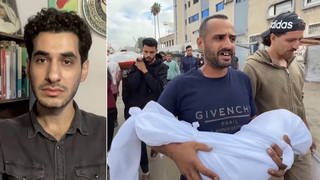
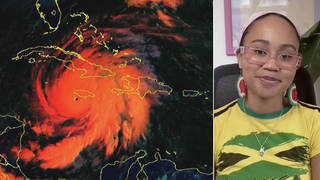
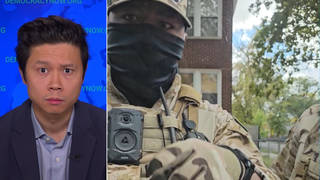
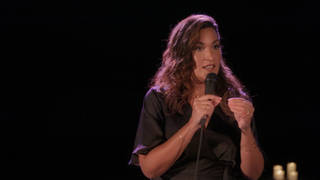





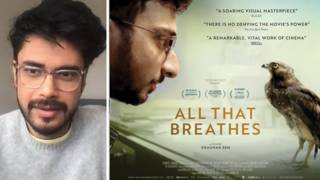
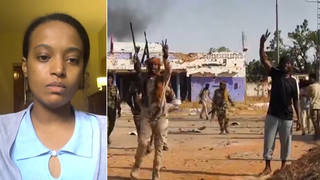
Media Options